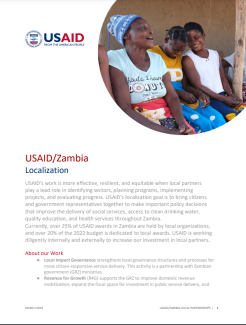Localization
USAID’s work is more effective, resilient, and equitable when local partners play a lead role in identifying sectors, planning programs, implementing projects, and evaluating progress. USAID’s localization goal is to bring citizens and government representatives together to make important policy decisions that improve the delivery of social services, access to clean drinking water, quality education, and health services throughout Zambia.
Currently, over 25% of USAID awards in Zambia are held by local organizations, and over 20% of the 2022 budget is dedicated to local awards. USAID is working diligently internally and externally to increase our investment in local partners.
About our Work
- Local Impact Governance strengthens local governance structures and processes for more citizen-responsive service delivery. This activity is a partnership with Zambian government (GRZ) ministries.
- Revenue for Growth (R4G) supports the GRZ to improve domestic revenue mobilization, expand the fiscal space for investment in public service delivery, and poverty reduction. R4G works with the Ministry of Finance and the Zambia Revenue Authority.
- Accountable Governance in Service Delivery (AGIS) is a locally-driven activity that works to strengthen Zambia’s capacity to oversee the use of public resources. AGIS supports government institutions that focus on Public Financial Management.
- Zambia Accessible Markets for Health (ZAM-Health) works with private-sector firms to provide goods and services at subsidized prices and to provide affordable health services through the National Health Insurance Scheme.
- Global Health Supply Chain program supports the Ministry of Health (MOH) to improve the availability and safety of key commodities by strengthening the logistics information systems and advancing efficiency and effectiveness in warehousing and distribution.
- Transforming Teacher Education (TTE) strengthens institutional and instructional capacity in ten Zambian Colleges of Education and two universities to support Zambia to transform the primary education system sustained with local resources.
- Government-to-Government Partnership: USAID provides support to Central, Copperbelt, Luapula, and Northern Provinces to advance the MOH’s effort in addressing gaps identified in health service delivery.
- Enterprise Development and Growth Enhanced (EDGE) increases the profitability for agricultural small and medium-sized enterprises (SMEs), strengthens the ability of banks and microfinance institutions, and builds the capacity of financial service providers.
- Local Works is USAID’s flagship program that seeks to empower local actors to lead their own development and help shift USAID’s role to be a catalyst for local change efforts and processes. Funding is awarded to local organizations.
- New Partnership Initiative (NPI) approach seeks to further diversify USAID’s partner base and increase assistance directly to credible local partners by strategically lowering the barriers faced by non-traditional partners.
Successes
- The Presidential Malaria Initiative (PMI) and other partners' contribution to the National Malaria Elimination Strategic Plan (2022- 2026) has led to an evidence-based, informed strategy and created a data use and learning culture in Zambia’s malaria control space. PMI and others invested in data collection and use established a network of entomologic monitoring sites, scaled up Malaria diagnosis and rapid testing, and conducted regular household surveys.
- Global Health Supply Chain connected health facilities, regional hubs, and Zambia Medicines and Medical Supplies Agency central warehouse to avert possible stock-outs of health commodities by using a reliable, real-time data system.
- USAID supported the MOE and other partners to distribute 1.9 million English and seven local languages teaching and learning materials for early childhood education up through Grade 3.
- Leveraged tens of millions of dollars through private-sector actors, created jobs, and strengthened the agricultural economy and environment through resource partnerships enabled by USAID’s conservation and biodiversity programs.

